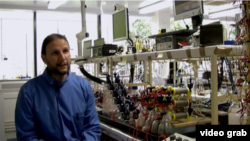In the near future, you may be able to recharge your cell or smart phone with a urine powered generator.
Dr. Ioannis Ieropoulos, a scientist at the University of Bristol in England, says he used such a generator to charge a widely available smart phone with enough power to enable SMS messaging, perform web browsing and make a brief call.
“We are very excited as this is a world first,” he said. “No one has harnessed power from urine to do this so it's an exciting discovery. Using the ultimate waste product as a source of power to produce electricity is about as eco as it gets.”
The power is generated by urine passing through what scientists call microbial fuel cells (MFCs). Inside the cells, microorganisms metabolize the urine and produce electricity in the process. The electricity output from MFCs is relatively small.
An added benefit, according to the scientists, is that what’s left of the urine is purified and can be released into the environment without having to go through a waste treatment plant.
Now that the concept has been proved, Ieropoulos says the process needs to be refined so that MFCs can charge a cell phone battery to full capacity.
One day, MFCs could be installed into bathrooms to harness the power of urine and could supply enough electricity to power lighting, and other small appliances.
“One product that we can be sure of an unending supply is our own urine,” said Ieropoulos. “The beauty of this fuel source is that we are not relying on the erratic nature of the wind or the sun; we are actually reusing waste to create energy.”
Here's a short video about the process:
Dr. Ioannis Ieropoulos, a scientist at the University of Bristol in England, says he used such a generator to charge a widely available smart phone with enough power to enable SMS messaging, perform web browsing and make a brief call.
“We are very excited as this is a world first,” he said. “No one has harnessed power from urine to do this so it's an exciting discovery. Using the ultimate waste product as a source of power to produce electricity is about as eco as it gets.”
The power is generated by urine passing through what scientists call microbial fuel cells (MFCs). Inside the cells, microorganisms metabolize the urine and produce electricity in the process. The electricity output from MFCs is relatively small.
An added benefit, according to the scientists, is that what’s left of the urine is purified and can be released into the environment without having to go through a waste treatment plant.
Now that the concept has been proved, Ieropoulos says the process needs to be refined so that MFCs can charge a cell phone battery to full capacity.
One day, MFCs could be installed into bathrooms to harness the power of urine and could supply enough electricity to power lighting, and other small appliances.
“One product that we can be sure of an unending supply is our own urine,” said Ieropoulos. “The beauty of this fuel source is that we are not relying on the erratic nature of the wind or the sun; we are actually reusing waste to create energy.”
Here's a short video about the process:












